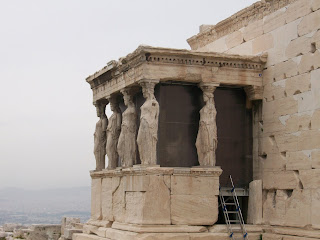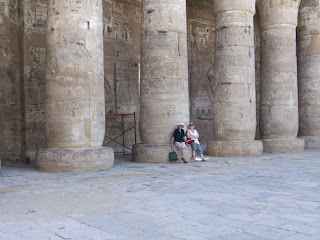Athens is a beautiful place if a little down-at-the-heels. A concerned citizen who we met on the bus from the airport (and who had spent some time in Philadelphia, so spoke English with an American Greek accent), took great care to warn us about Greek drivers and that crossing the street is a dangerous and possibly life-threatening activity in Athens. Our experience is that Greek drivers are very like Egyptians when it comes to respecting the rules of the road.
We checked into our hotel in Plaka, a trendy district in downtown Athens, and were gratified to find that we could see the Acropolis from our hotel room window. That night we celebrated Nikos' birthday by having our first of many fine taverna meals. The roast lamb was excellent, cooked in clay pots.
The next day we went up to the Acropolis, despite intermittent rain. We were fortunate that the staff had returned to work, as they had been on strike for weeks. Apparently they have not been paid in months, a reflection of the perilous financial state of the Greek government, that is chronically short of funds, another reflection of the world economic crisis.
 We did get to see the Temple of Athena Nike, the Parthenon, and the Erechtheion, with its most famous southern portico supported by the much-photographed statues of six maidens, the Caryatids (see photo). Nikos and I took a walk in the rain in the afternoon, and saw Hadrian's Gate, named for the Roman emperor, and the Olympic Stadium, built in 1896 entirely of marble, to house the first modern olympic games.
We did get to see the Temple of Athena Nike, the Parthenon, and the Erechtheion, with its most famous southern portico supported by the much-photographed statues of six maidens, the Caryatids (see photo). Nikos and I took a walk in the rain in the afternoon, and saw Hadrian's Gate, named for the Roman emperor, and the Olympic Stadium, built in 1896 entirely of marble, to house the first modern olympic games.The next day was sunnier, and we saw the National Archeological museum, full of ancient statuary and fabulous gold and bronze artifacts and jewelry from the centuries that Greece was the cultural and intellectual leader of the ancient world.
We went to the Athens open air meat and fish market. There was every kind of fish imaginable including tuna, shark, as well as marlin, plus prawns, crab, squid and octopus, all displayed on
 crushed ice. There were also sides of beef, pork and lamb, hanging without benefit of refrigeration, and also all of the organ meats in large tubs. Rabbits were hung skinned, but their hind feet and tails were still attached, probably for good luck, but of course luck had run out for the rabbits. The butchers all smoked, and laughed and joked with each other and with their customers as they cut the meats, a perpetual cigarette butt dangling from the corners of their mouths. It was a sight that would reduce a Canadian health inspector to a quivering, stuttering mass of indignation.
crushed ice. There were also sides of beef, pork and lamb, hanging without benefit of refrigeration, and also all of the organ meats in large tubs. Rabbits were hung skinned, but their hind feet and tails were still attached, probably for good luck, but of course luck had run out for the rabbits. The butchers all smoked, and laughed and joked with each other and with their customers as they cut the meats, a perpetual cigarette butt dangling from the corners of their mouths. It was a sight that would reduce a Canadian health inspector to a quivering, stuttering mass of indignation.After leaving the market we went across the street fot a late lunch. We ate delicious gyros from a busy stall, savouring the slightly smoky taste. We then walked back to the hotel via Monasteraki square. Later that evening we met Thanassis Samaras (formerly of Injured Workers Consultants in Toronto) and his partner Mina, who took us to a lovely local taverna for a late evening snack and some wine.
The next day we bummed around Athens and prepared to depart for Syros, an island in the Aegean.











